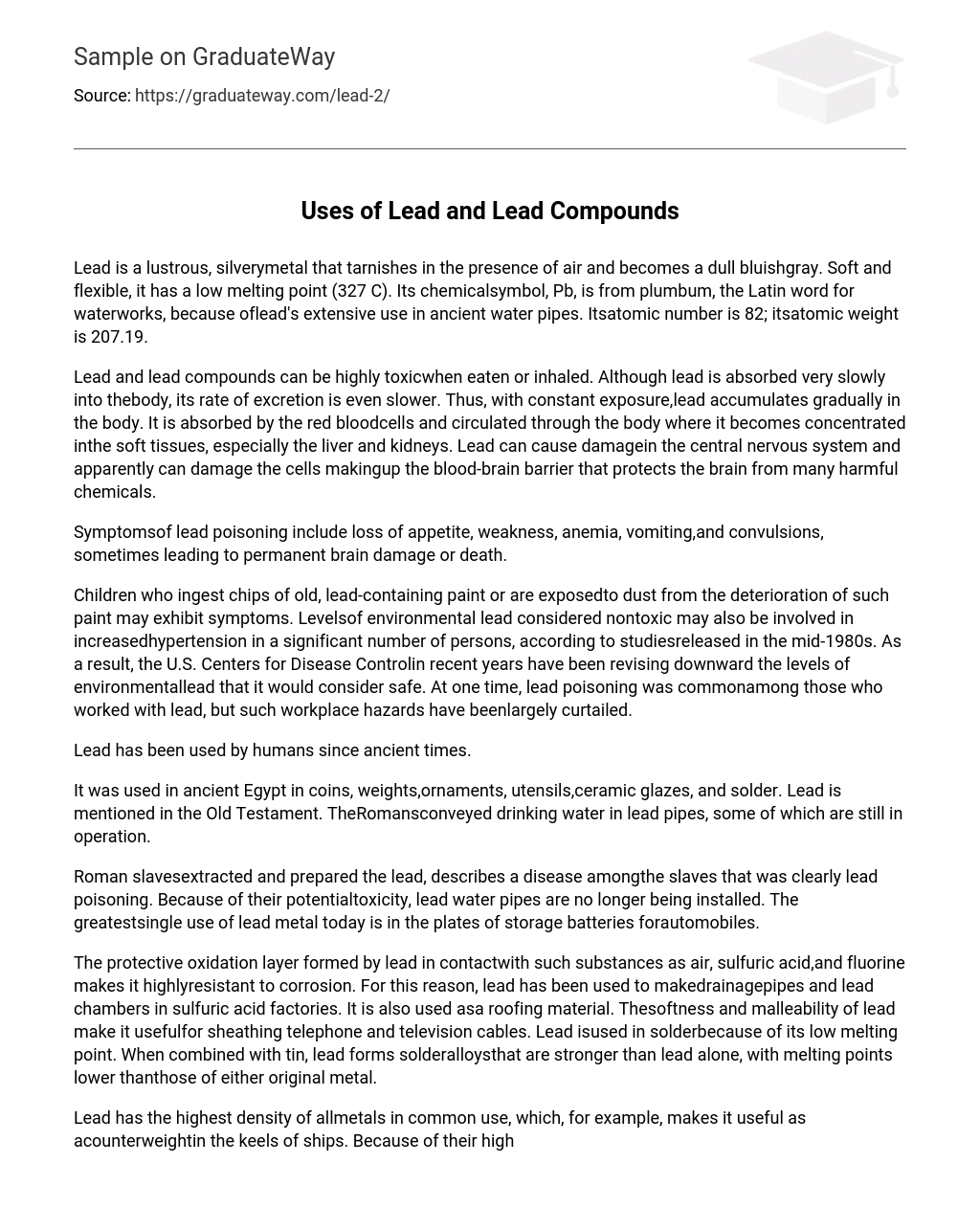Lead is a lustrous, silverymetal that tarnishes in the presence of air and becomes a dull bluishgray. Soft and flexible, it has a low melting point (327 C). Its chemicalsymbol, Pb, is from plumbum, the Latin word for waterworks, because oflead’s extensive use in ancient water pipes. Itsatomic number is 82; itsatomic weight is 207.19.
Lead and lead compounds can be highly toxicwhen eaten or inhaled. Although lead is absorbed very slowly into thebody, its rate of excretion is even slower. Thus, with constant exposure,lead accumulates gradually in the body. It is absorbed by the red bloodcells and circulated through the body where it becomes concentrated inthe soft tissues, especially the liver and kidneys. Lead can cause damagein the central nervous system and apparently can damage the cells makingup the blood-brain barrier that protects the brain from many harmful chemicals.
Symptomsof lead poisoning include loss of appetite, weakness, anemia, vomiting,and convulsions, sometimes leading to permanent brain damage or death.
Children who ingest chips of old, lead-containing paint or are exposedto dust from the deterioration of such paint may exhibit symptoms. Levelsof environmental lead considered nontoxic may also be involved in increasedhypertension in a significant number of persons, according to studiesreleased in the mid-1980s. As a result, the U.S. Centers for Disease Controlin recent years have been revising downward the levels of environmentallead that it would consider safe. At one time, lead poisoning was commonamong those who worked with lead, but such workplace hazards have beenlargely curtailed.
Lead has been used by humans since ancient times.
It was used in ancient Egypt in coins, weights,ornaments, utensils,ceramic glazes, and solder. Lead is mentioned in the Old Testament. TheRomansconveyed drinking water in lead pipes, some of which are still in operation.
Roman slavesextracted and prepared the lead, describes a disease amongthe slaves that was clearly lead poisoning. Because of their potentialtoxicity, lead water pipes are no longer being installed. The greatestsingle use of lead metal today is in the plates of storage batteries forautomobiles.
The protective oxidation layer formed by lead in contactwith such substances as air, sulfuric acid,and fluorine makes it highlyresistant to corrosion. For this reason, lead has been used to makedrainagepipes and lead chambers in sulfuric acid factories. It is also used asa roofing material. Thesoftness and malleability of lead make it usefulfor sheathing telephone and television cables. Lead isused in solderbecause of its low melting point. When combined with tin, lead forms solderalloysthat are stronger than lead alone, with melting points lower thanthose of either original metal.
Lead has the highest density of allmetals in common use, which, for example, makes it useful as acounterweightin the keels of ships. Because of their high density, lead bullets andshot encounterlittle air resistance and thus achieve excellent strikingpower. Shot is produced by allowing moltenlead to drip down from heightsup to 38.10 m (125 ft). The drops become spherical and arecondensedby the cooling action of the air before being collected in a tank filledwith water or oil.
Lead’s density and softness also make it highly suitablefor damping sound and vibrations. To isolatethem from vibration, heavymachinery and even whole buildings are placed on lead blocks. Becausetheeffectiveness of shielding against gamma and X rays depends largely onthe density of the shield,lead is used in the protective shielding ofX-ray machines and nuclear reactors. Tetraethyl lead or tetramethyllead (PbEt4) has often been added to gasoline to improve engine efficiencyandreduce gasoline consumption in automobiles. Because of the toxic effectof lead on theenvironment, however, plans call for phasing out thisuse. Lead azide is sensitiveto striking and is highly explosive; itis frequently used as a detonator of explosives. Lead iodide is alightyellow substance that is used as a dye in such processes as coloring bronze.
It haslight-sensitive properties comparable to those of silver salts.
MoreUsesthe metal and the dioxide are used in storage batteries, cablecovering, plumbing, ammunition manufacture of PbEt4 – an antiknockcompound in petrol.
environmental concern with lead poisoning, (andcheaper unleaded petrol prices) is slowly resulting in less use of leadin petrol the metal is very effective as a sound absorber, a radiationshield around X-ray equipment and nuclear reactors used extensivelyin paints, although recently the use of lead in paints has been drasticallycurtailed to eliminate or reduce health hazards the oxide is usedin producing fine “crystal glass” and “flint glass” with a high refractiveindex for achromatic lenses solder used by the Romans for plumbing(the decline of the Roman empire is attributed to lead in the water supply!)used to contain corrosive liquids alloying cable coveringammunition shield against X-rays oxide used to produce crystalglass insecticidesWords/ Pages : 759 / 24





